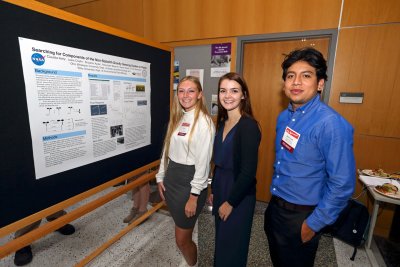SSRP Abstract
Searching for Components of the Non-Statolith Gravity Sensing System in Plants
 Students: Lexie Chafin ’20, Claudia Kelly ’20, and Brayams Ayala Ramos ’20
Students: Lexie Chafin ’20, Claudia Kelly ’20, and Brayams Ayala Ramos ’20
Research Mentor: Chris Wolverton (OWU Department of Botany-Microbiology)
Gravity is a ubiquitous and persistent force on Earth and serves as one of the most important cues underlying plant architecture and directing plant growth. One system plants use to transduce this physical force into cellular information is based on the sedimentation of dense, starch-filled organelles called amyloplasts, which act as statoliths in the cell. Throughout seedling establishment and early growth, statolith sedimentation activates a series of signaling events that regulate differential growth, maintaining organs in a particular position within the gravity field. Despite the central role of statolith sedimentation in mediating gravity responses, work in our lab and others have shown that plants maintain some degree of gravity responsiveness even in the absence of starch-filled statoliths, which suggests the function of another sensing system. We used RNA-seq to identify differences in early (10 min post stimulation) gravity-responsive genes in wild-type and starchless mutants (see Meyers et al., this program). Here we report the initial screening and phenotypic characterization of mutants in approximately 30 candidate genes revealed through the differential gene expression analysis. In addition to typical gravitropic phenotype analysis through image analysis on free-responding root tips, we introduce a novel approach to identify deficiencies in gravity response parameters based upon our previous feedback-based rotation system, ROTATO. By subjecting seedlings to constant rotation at a fixed rate using a programmable motor control circuit, we were able to identify differences between mutants and wild-type responses more readily than with free response assays alone. The simplicity and low cost, coupled with the ability to subject multiple seedlings to the treatment at a time, make this a potentially useful tool for the community. Results of the ongoing mutant analysis and potentially exciting candidate genes will be discussed.
As everyone knows, plant stems grow up towards the sun and their roots grow down into the ground. How do they know which way to grow? Cells in the root tips of plants contain starch-filled organelles, called amyloplasts, which are heavy and settle at the bottom, causing the roots to grow downward. Scientists have found, however, that roots still grow down even when they are missing these amyloplasts. Our lab is researching to find the genes that cause plants to respond to gravity even when they are mutated to not have starch. We are accomplishing this by growing plants with over thirty different single mutations in the genes that are expressed in gravity response and recording the growth and angles of the root tips in every plant. Our goal is to narrow down a list of genes that are active in plant gravity response, even when plants have no starch, in order to get a better understanding of the processes by which plants grow successfully.
